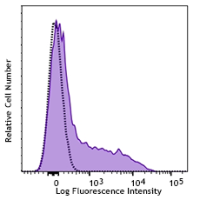-
Sign In
-

-
 Sony Biotechnology
Sony Biotechnology
-

-
 Sony Biotechnology
Sony Biotechnology
Brilliant Violet 750™ anti-human CD137 (4-1BB)
Antibodies Single
Sony
4B4-1
Flow Cytometry
Mouse IgG1, κ
Human,Non-human primate,Other
Ectodomain of recombinant human 4-1BB fusion protein
2149220
$445.00
Description
CD137 is a 39 kD transmembrane protein also known as 4-1BB. It is expressed on activated T cells. CD137 is a type I membrane protein and a member of the tumor necrosis factor receptor superfamily. CD137 appears to be important for T cell proliferation and survival, and induces monocyte activation through its interaction with 4-1BB ligand.
Formulation
Phosphate-buffered solution, pH 7.2, containing 0.09% sodium azide and BSA (origin USA)Recommended Usage
Each lot of this antibody is quality control tested by immunofluorescent staining with flow cytometric analysis. For flow cytometric staining, the suggested use of this reagent is 5 µL per million cells in 100 µL staining volume or 5 µL per 100 µL of whole blood. It is recommended that the reagent be titrated for optimal performance for each application.
Brilliant Violet 750™ excites at 405 nm and emits at 750 nm. The bandpass filter 780/60 nm is recommended for detection, although filter optimization may be required depending on other fluorophores used. Be sure to verify that your cytometer configuration and software setup are appropriate for detecting this channel. Refer to your instrument manual or manufacturer for support. Brilliant Violet 750™ is a trademark of Sirigen Group Ltd.
This product is subject to proprietary rights of Sirigen Inc. and is made and sold under license from Sirigen Inc. The purchase of this product conveys to the buyer a non-transferable right to use the purchased product for research purposes only. This product may not be resold or incorporated in any manner into another product for resale. Any use for therapeutics or diagnostics is strictly prohibited. This product is covered by U.S. Patent(s), pending patent applications and foreign equivalents.
References
- Garni-Wagner B, et al. 1996. Cell. Immunol. 169:91. (IP)
- Salih HR, et al. 2000. J. Immunol. 165:2903. (FA)
- Kienzle G, et al. 2000. Int. Immunol. 12:73. (FA)
- Langstein J, et al. 1998. J. Immunol. 160:2488. (IP)


